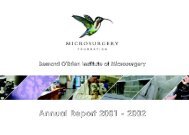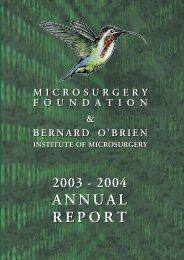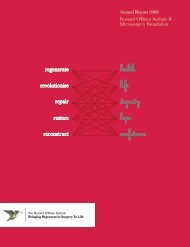2990 Microsurgery.qxd - O'Brien Institute
2990 Microsurgery.qxd - O'Brien Institute
2990 Microsurgery.qxd - O'Brien Institute
You also want an ePaper? Increase the reach of your titles
YUMPU automatically turns print PDFs into web optimized ePapers that Google loves.
Scientific Research<br />
Bernard O’Brien <strong>Institute</strong> of <strong>Microsurgery</strong><br />
BOBIM SCIENTIFIC REPORT 1997-98<br />
General Introduction<br />
The scientific activities of the <strong>Institute</strong> have<br />
expanded over the last year with several new<br />
projects in:<br />
• angiogenesis,<br />
• tissue engineering,<br />
• ischaemia-reperfusion injury, and<br />
• nerve regeneration<br />
An investigation of the role(s) of nitric oxide, a<br />
gaseous molecule made by blood vessels and<br />
white blood cells, has continued as a major<br />
focus in investigations of cell death following<br />
periods of low blood flow. Recently one of the<br />
enzymes making nitric oxide has been localised<br />
to mast cells, a cell type not previously thought<br />
to play a major role in ischaemic injury to<br />
skeletal muscle.<br />
A new model of angiogenesis (new blood<br />
vessel formation), with relevance to the clinical<br />
situation, has been developed. This model is<br />
being used to identify agents which either<br />
promote or inhibit development of new blood<br />
vessels, with clinical applications in tissue<br />
engineering, vascular disease and cancer.<br />
Further work on leukaemia inhibitory factor (LIF)<br />
has confirmed its muscle preserving action and<br />
shown that the agent is transported from the<br />
site of nerve injury to the muscle by specific<br />
transport down the nerve. This important<br />
finding provides further impetus to the<br />
application of LIF to sites of nerve injury<br />
being repaired by microsurgery.<br />
Our work on macrophage cells continues to<br />
provide us with important new insights into the<br />
molecular mechanisms controlling macrophage<br />
function, and role of these cells in inflammation,<br />
wound repair and blood vessel formation.<br />
The past year has also witnessed several<br />
initiatives involving genetically modified<br />
(transgenic/knockout) mice in which models of<br />
ischaemia-reperfusion injury and angiogenesis<br />
have been created and tested. Such<br />
developments provide a significant technical<br />
challenge for our highly skilled microsurgeons,<br />
but will but enable us to break new ground in<br />
understanding these complex clinical problems.<br />
12






